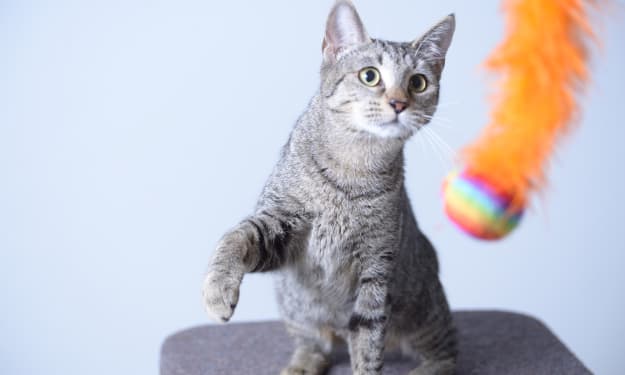The cat family, felines, has thirty-seven species. They are all carnivorous mammals that are native to most areas on the Earth with the exception of Australia and Antarctica. These species include: lions, tigers, leopards, jaguars, cheetahs, lynxes, and, of course, the domestic cat.
They are wild animals—even the domestic cat can easily become wild, and most photos of these animals have been taken from a safe distance with telephoto lenses. However, a search of any of the species will reveal spectacular photos of these animals. Some of the normally wild species have been tamed and there are also some great photographs of these animals interacting with people.
Domestic cats are the only species of the feline group that I have had the opportunity to photograph, and I have taken many hundreds of photographs of them.
I do have a love/hate relationship with cats. When I think of the carnage the escapees, the wild ones, have done to our native wildlife here in Australia, that relationship is most definitely in the hate category.
In an article in the 2015 edition of the Journal of Biography, it was reported that an examination of the faeces of wild cats in Australia showed that 400 species of Australian mammals are consumed by them, thus threatening the ongoing existence of all of these species. Cats have already been major contributors to the extinction of 16 species of mammals in Australia.
However, when I work with pet cats, my heart melts, and it is impossible not to love them. So, if you have a cat, or cats, please look after it/them, and don’t allow escapees into the wild. Unless you intend to breed professionally, have your pet(s) spayed.
The naturally wild nature of cats is apparent when you try to photograph them. Dogs, for example, generally try to please, and are usually much easier to work with. Cats require you to please them and are not anywhere near as cooperative as the canines.
Cats from a photographer’s point of view can therefore be a challenge. But some of us are a bit weird and enjoy that challenge.
How then can we obtain good photographs of domestic cats?
Firstly, where the photographs are to be taken is relevant. Is the shooting going to occur inside or outside, where the cat actually lives or in a photographer’s studio or elsewhere?
Shooting outside can be an option, but there is often the possibility the puss will clear out if it does not want to be photographed. Being confined indoors is generally a safer option, but this also presents some potential problems.
Natural light is preferred for shooting cats. So, from a lighting point of view, outside is beaut. But, if indoors, you will need to find a room that is well lit with natural light or use artificial light.
Avoid using flash if at all possible. Chances are that Cup Cake will not appreciate the flashing light and will try to clear out. LED panels are probably the best option with regard to artificial lights. They are relatively inexpensive to purchase and operate. And, you can choose bulbs that have a similar colour to natural light.
If it is your cat you are shooting, it should be used to you being around and not be phased by the camera and any additional equipment. If it is not used to cameras, etc., give it additional time to do so. Cats usually cannot be rushed. You need to work in their time.
An assistant to distract and/or play with the cat can be advantageous, particularly if that assistant is a part of the cat’s family.
If you are shooting in an area the cat is not familiar with, don’t attempt any outdoor shooting. You may never see Mogsi again. If it is a studio setting, make sure doors are shut so that the area that Mogsi has to play and explore is limited. But, give the cat time. Let it get used to and familiar with its surroundings. The cat will need more time to become relaxed than would be the case in places it was familiar with. Your patience should pay off in better photographic results.
As with shooting in the cat’s familiar territory, an assistant will be an asset. Let the photographer do the shooting whilst the assistant gets the cat’s attention and gets it to perform. Some props will also help.
A stand or a table is useful, otherwise the photographer should try to get down to the cat’s level. And, for someone like me, that could be a problem. Toys, ribbons, bells and squeaky toys can also assist.
It can be difficult, but endeavour to get the cat looking at the camera. The photographer may have to stand immediately behind their assistant for the cat to do this. If the cat looks at the camera, and your camera has the appropriate facility, try to spot focus on the cat’s nearest eye to the camera.
Get in close to the cat for your shots, or use a long lens to make the cat appear closer. The cat is the subject. Get it filling most of your frame.
If you have continuous shooting mode on your camera controls, then use them. Often in a burst of photos over a couple of seconds, one or two may be outstanding. They are the shots you are looking for.
When film cameras were in general use, more care had to be taken with composition and framing of shots. Otherwise, the exercise could become very expensive. Composition and framing is still important with digital cameras, but the expense of shooting lots of shots is not an issue. Take heaps of shots and in the editing process, just keep the ones which look good.
About the Creator
Ian McKenzie
Lover of life and all it has to offer. Retired from full-time employment, but keeping busy with things I am passionate about including: family, friends, photography, writing, sustainability and keeping Australian native stingless bees.






Comments
There are no comments for this story
Be the first to respond and start the conversation.